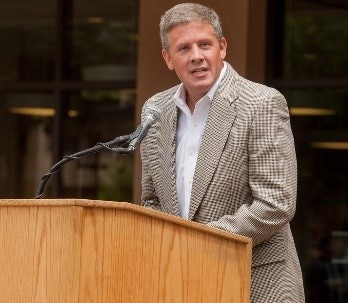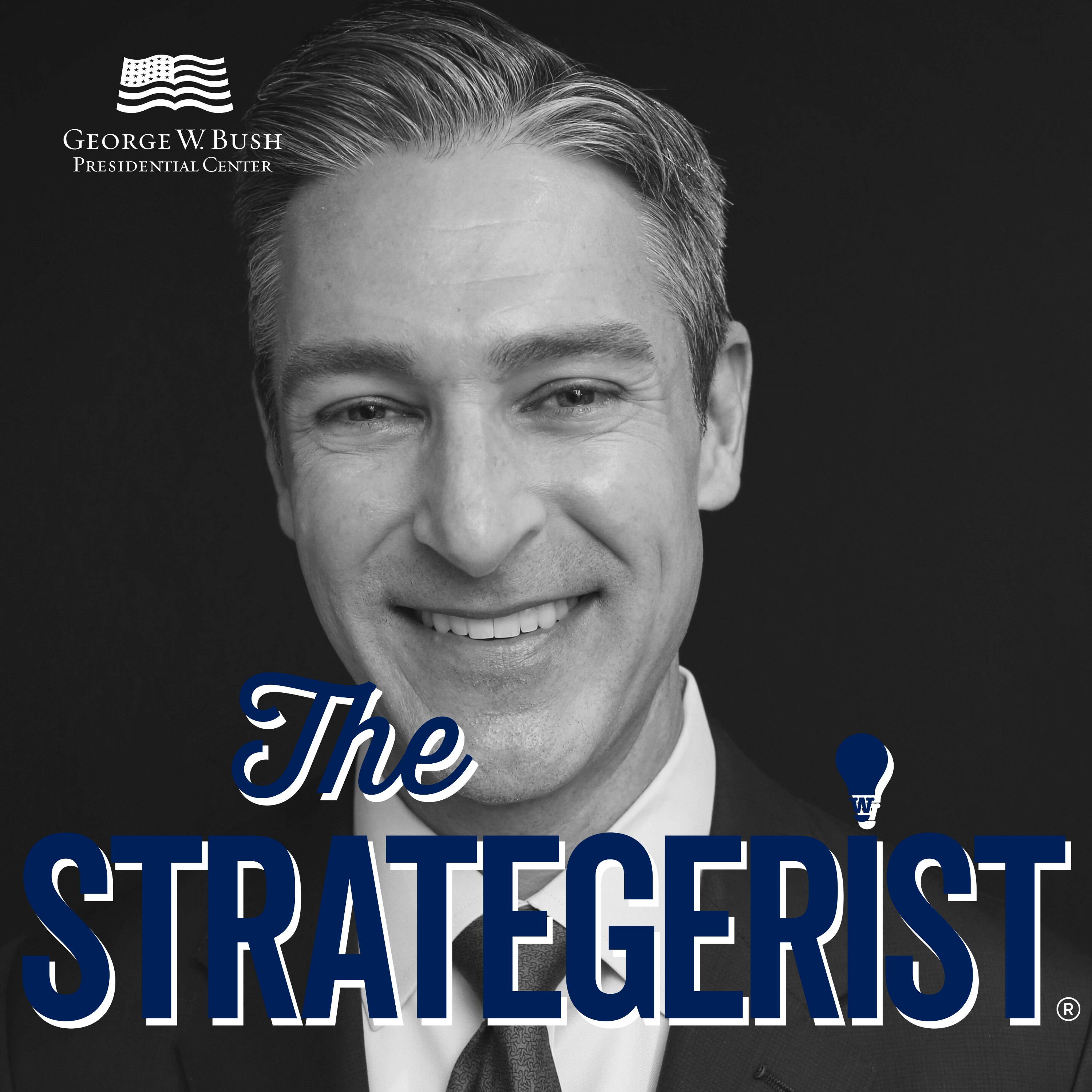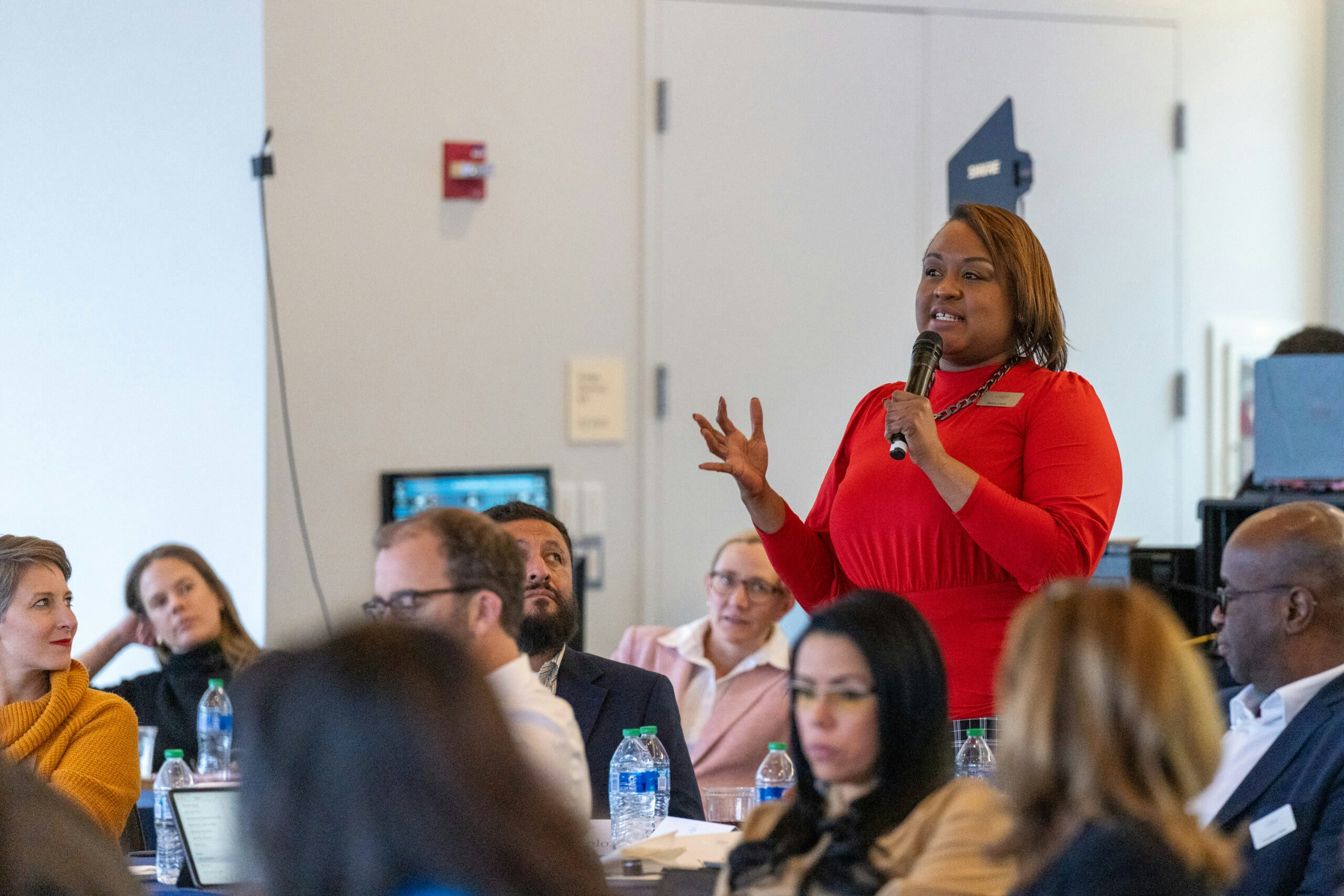Keith Hennessey, a Lecturer at the Stanford Graduate School of Business and the David M. Rubinstein Fellow at the George W. Bush Institute, details how he works to explicitly create respect and charity in his classroom discussions and debates.
Keith Hennessey is a Lecturer at the Stanford Graduate School of Business and the David M. Rubinstein Fellow at the George W. Bush Institute, where he is the lead faculty member for the Presidential Leadership Scholars program. Prior to those positions, he served as Deputy Director and then Director of the National Economic Council under President George W. Bush. He previously advised former GOP Senator Trent Lott of Mississippi on economic issues and worked for the Senate Budget Committee.
The Stanford University and Harvard Kennedy School graduate draws upon those experiences in this conversation about civil dialogue with Lindsay Lloyd, the Bradford M. Freeman Director of Human Freedom at the Bush Institute, Chris Walsh, Senior Program Manager in the Human Freedom Initiative, and William McKenzie, Senior Editorial Advisor at the Bush Institute. In Hennessey’s eyes, civil dialogue requires respect and charity. He details how he works to explicitly create those in his classroom discussions and debates.
What is your definition of civil dialogue?
The key word would be “respect.” Are the participants treating each other with respect? Closely related is the principle of charity, which is assuming or even pretending to assume, that the person with whom you are engaged in dialogue is coming from a place of good intentions. And charity means treating them as if they are trying to make America or the world a better place, that they’re trying to be a good person in their heart.
Those are the two elements. Respect for the person with whom you’re sitting, and assuming the best intent of what they are saying.
That hearkens back to something President Bush said after several police officers were killed in the streets of Dallas five summers ago. He talked about how we too often judge others by the worst possible standard and ourselves by the best possible standards.
I remember that. When we behave uncivilly, we judge our opponents by their own worst outcomes. And it’s not just best versus worse. In too much of today’s unconstructive public dialogue, I’m judging myself based on what’s in my heart, and I’m judging you based on the results of what you’re proposing.
Exactly. So how do civil discussions take place in your classrooms?
I have put more than a decade into refining my techniques for trying to make my classroom a place where we can engage in civil dialogue, discussion, and debate. I would not say that I have figured out the magic solution, because it is a constantly evolving process. But I consider it probably as important as the substantive policy content that I’m teaching.
Those are the two elements. Respect for the person with whom you’re sitting, and assuming the best intent of what they are saying.
How do you structure those discussions?
I usually start off the opening class of the quarter by saying, “We’re all familiar with the way that public policy is debated out there in the world and in the media. And we don’t have to go into all the things that we don’t like about that. My guess is that we all have images in our mind of what is better. My goal here is to try and create that. We are going to debate policy the way we wish elected officials did.”
After I create that standard, I explain how we’re going to do it. I explain that I was a Senate staffer, and that there is a tradition in the Senate of referring to your colleagues as “my good friend,” “my dear friend,” or “the Senator from Colorado.” Even if one senator can’t stand another in real life, there’s an enforced, almost artificial politeness that happens in the way they debate each other in public. That reduces the name calling and the venom that’s being spit at one another.
I basically tell my students that I want them to go hammer and tong at each other’s arguments, but don’t attack the person. No holds barred in terms of the intellectual debate. But you have to treat people with respect and assume they’re coming from a good place. You don’t make it personal.
I basically tell my students that I want them to go hammer and tong at each other’s arguments, but don’t attack the person. No holds barred in terms of the intellectual debate. But you have to treat people with respect and assume they’re coming from a good place.
When a student violates that, I gently prod them to not judge the other person’s intent. They quickly accommodate. And when they see that it starts working, they’re even more excited to treat others with respect and charity.
What role should schools and universities play around free speech to make sure that civil dialogue is happening?
I am extremely hesitant to give an answer for universities plural. It is for the leaders of the institution to figure out the ethos of the school and what’s important to that particular college or university.
I am a freedom-of-speech and freedom-of-debate guy. So, I love the University of Chicago principles. The University of Chicago president came out and said we are committed to freedom of speech and open debate, even if it upsets you, and we push that very aggressively.
I’m attracted to that. But the leadership at every university has different ways of balancing their priorities.
What leads students to deeper engagement within their communities and society in general?
I am often struck by how much I take for granted that many of my students have never been taught or experienced. My students now were born in the 1990s. They were in elementary school or early middle school on 9/11. Not only do they not remember the Cold War, but they don’t have any experience with a pre-9/11 environment as adults.
Sometimes, I have to explain that bipartisan legislative efforts have existed and can exist. There has been little major bipartisan legislation at the national level over the past 10 years, so they have no experience seeing a big, dramatic bipartisan compromise. They don’t know about it, and that’s not their fault. But I try to show them examples of bipartisanship, and assert that, based on my experience, bipartisan legislation can happen again in the future.
The same is true in terms of civil discussion. If you’ve never been involved in really intense debate over gun control with someone who actually believes in gun rights, it can open your eyes. We’re often in our little bubbles, and never actually engage with people who are as smart or as well-intentioned as we think we are. But when we do engage like that, we see that people just come to a different conclusion because they have a different life experience, a different set of value prioritizations, and a different background.
I try to make encounters like that happen. It’s disappointing how many students have grown up in these bubbles. I’m trying to break the bubbles and see if something interesting arises.
The public environment is not conducive to these kinds of encounters. If you try to engage with someone in that way through social media, there are a hundred or a thousand people who can jump into the conversation uninvited and try to blow things up.
What is the reaction when you describe to students how bipartisanship can happen or has happened?
The reactions are mixed. A lot of them give me some benefit of the doubt that I’m not intentionally trying to mislead them. They’ll say, “Okay, can you show me some more examples. Point me towards some historic descriptions?”
So, I point them to a press conference of (then-Bush Administration Treasury Secretary) Hank Paulson, (then-House Minority Leader) John Boehner, and (then-Speaker of the House) Nancy Pelosi announcing a stimulus bill in 2008 or describing the TARP negotiations that occurred in the fall of 2008. Concrete examples make a difference.
I do not find problems in terms of open-mindedness and willingness to engage with new or uncomfortable topics, or topics that you disagree with. You hear that a lot about universities, that students are close-minded. I don’t see that in my classroom. The horror stories about repressive environments don’t exist in my classrooms.
You have put your finger on a real challenge for our democracy: How do you reach people for whom some degree of commonality or respectful dialogue and debate has not been part of their experience? How do you create those dialogues?
I don’t have good answers to extend to a broader context. I wish I did.
But I have done something over the past few years with my students, which is to get them to find and interview a Trump supporter. There’s not a lot of support for Mr. Trump on a top college campus. And to the extent there are Republicans or conservatives on campus, they tend not to fall into the Trumpian subset of those worlds.
So, I tell them, I want you to find someone who genuinely supports him, and I want you to interview them for an hour. Then I want you to come back into the classroom and explain why the person you interviewed supported President Trump. I make my students speak as if they are the person that they interviewed, to speak in the first person on behalf of their interviewee. I want them to try to create that empathy link.
In the classroom, I can police anyone who breaks the norms. Out in public or on Twitter anyone can jump in. There’s no incentive for people to behave according to norms that will elevate the discussion. The trolls can always interject, whereas I have a greater ability to keep them out.
One of the core questions then is, how can you create discussions where a moderator can exclude the people who are clearly trying to cause the discussion to fall apart?
I have put more than a decade into refining my techniques for trying to make my classroom a place where we can engage in civil dialogue, discussion, and debate. I would not say that I have figured out the magic solution, because it is a constantly evolving process.
Are there particular issues that animate your students?
Immigration gets them very fired up. I would love them to care about economic growth and opportunity and free trade as much as I do. But when I teach them about income and wealth distribution, they all want to talk about that. They are very focused on distributional economics. Also on energy, the environment, climate change. That is just a generational shift. Those are a lot of them.
I’m at a business school. I’ve been shifting my teaching over the past few years to focus more on frictions between your role as a business leader and as a spokesperson for your values out in society. Questions about the function of business and the function of a company leader. And how should you think about your different roles as, say, a member of your church or synagogue or mosque, and as the leader of a for-profit business? How do you deal with those roles? The students are very interested in those things, and those questions are heating up fast in the real world.
Let’s return to your experience as a Senate staffer. You have 100 senators, and all those offices are together, and the staffers know each other. How did dialogue happen there? And do lessons from that experience apply today?
Legislating is what mathematicians call a repeated game. You’re going to be interacting with these people over and over on a range of issues. If you want to be successful at legislating, you have to realize that this person who is your opponent on this issue might be a potential ally on the next issue. It would be smart not to treat them too poorly because you may need their help in the future.
The legislative procedures in the Senate also give the individual, or a minority faction, leverage to block something. It is harder for a determined majority to just steamroll the minority on a bill. These rules force you to compromise more often. Those two elements are quite significant.
I don’t want to suggest that conversations in the Senate when I was a staffer were all happiness and light and friendly. They were rough, and these people were serious opponents. You’re trying to beat them. And there are people you don’t like, and you can’t get along with.
But, in legislating, certain things have to get done. And you seek out people who can separate out the transactional work of legislating from the philosophical and values debates about other things.
In a public debate on Twitter, there’s no imperative for anyone to cooperate at a transactional level. Everyone is equally free to be unconstructive. The requirements placed on legislating change the dynamic from an open conversation between two citizens.
Are there places where you see respectful civil dialogue taking place around the country?
A lot of today’s debate does not feel like debate. It feels like performance, where the two people who claim to be debating each other are both on screen at the same time but are speaking to their own subsets of the common audience. They’re trying to fire up their subset of the crowd, and maybe win over a margin of it rather than looking at one another and engaging with the substance of the debate.
My dream is to have a group of House members or a group of senators from different ideological viewpoints who leverage the power of the House floor and the Senate floor and C-Span. You could get five House members right-of-center and five Democrats left-of-center who would, say, every Thursday night after their legislative session is over, engage for two hours in a philosophical debate about the overall values in our immigration system. Not the details, but big-picture debates. They would demonstrate for everybody else this is how you argue with one another.
A 19-year-old college sophomore could see, ah, here’s a model that I can follow rather than the model of people on cable TV’s so-called news programs, who aren’t actually engaging with one another. You need role models of this debate. Exemplars that people can see.




























